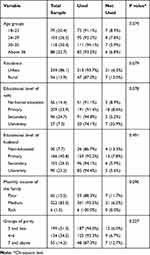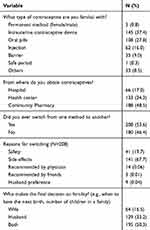Back to Journals » International Journal of Women's Health » Volume 12
Knowledge and Practice of Contraception Use Among Females of Child-Bearing Age in Mosul, Iraq
Authors Aldabbagh RO, Al-Qazaz HKh
Received 19 September 2019
Accepted for publication 20 February 2020
Published 2 March 2020 Volume 2020:12 Pages 107—113
DOI https://doi.org/10.2147/IJWH.S231529
Checked for plagiarism Yes
Review by Single anonymous peer review
Peer reviewer comments 2
Editor who approved publication: Professor Elie Al-Chaer
Raghad O Aldabbagh, Harith Kh Al-Qazaz
Department of Clinical Pharmacy, College of Pharmacy, University of Mosul, Ninevah 81011, Iraq
Correspondence: Harith Kh Al-Qazaz
Department of Clinical Pharmacy, College of Pharmacy, University of Mosul, Ninevah 81011, Iraq
Tel +9647509158045
Email [email protected]
Purpose: For thousands of years, fertility control has been used in different forms. This study was carried out to evaluate the knowledge and practice of participants regarding birth control methods with the prevalence of each method.
Patients and Methods: A cross-sectional study design was employed to evaluate knowledge and practice among females. Three family-planning centers were included in addition to 2 general hospitals. A total of 440 married women between the ages of 18 and 40 years were interviewed by the first author. Self-administered version of a previously translated questionnaire was used to evaluate practice and knowledge concerning contraception use.
Results: A total sample of 388 women of child-bearing age was interviewed. The mean age ± SD was 29.76 ± 6.67, while the mean number of their offspring was 4.06 ± 2.08. The intrauterine contraceptive device was the most frequently used method followed by oral contraceptive pills, while the safe-period method was the least frequently used. More than 50% of the females obtained their contraceptives from public health centers and/or hospitals. The mean number of contraception methods known by the females was 2.15 ± 1.07. Safety was the most indicated criterion for choosing the preferred method. Out of all the respondents, 86.9% indicated that they experience adverse effects from using contraceptive methods, in which a higher rate was for oral pills (31.1%), intrauterine contraceptive device (21.3%), or from both methods (18.4%).
Conclusion: This study disclosed an acceptable level of knowledge and positive practices among Iraqi women seeking health-care facilities with respect to birth control methods. Females with lower levels of education require continued education and regular communication about the importance of birth control to promote the use of modern contraceptive methods. The findings from this study will help to develop programs that can improve knowledge of females and services provided by the health-care system and can reduce adverse effects from contraception and the incidence of unplanned pregnancies.
Keywords: knowledge, contraception, birth control, Iraq
Introduction
For thousands of years, fertility control has been used in different forms,1 and coitus interruptus (withdrawal) is the oldest known method. Many recipes and instructions about contraception were prescribed by early Greek, Egyptian and Islamic physicians. Among them were Al-Razi who died about 923 AD (313 H) and Avicenna (980–1037 AD, 370-428 H).2 Islamic views on contraception along with Islamic medicine were introduced to Europe with the movement of Muslims and the consequent transfer of goods and ideas, particularly regarding medical reasons for avoiding childbearing.3,4 Social studies estimate that approximately 222 million couples do not use any type of contraceptives due to the lack of the required knowledge and means and at the same time these couples want to limit their family size 5. With the current level of growth, the world population is expected to increase to 9.2 billion in 2050,6 which will have devastating effects on the ability of the planet to cope. Results from one family planning research showed that the number of married women using contraception was projected to grow from 900 million in 2010 to 962 million in 2015.7
According to the United Nations, 63% of partnered, reproductive-aged women worldwide, representing about 740 million couples, practice some form of contraception. Modern methods like oral pills, condoms, injections, intrauterine devices and even sterilization were used by 90% of them. Contraceptive prevalence increased until 2000, but growth has stalled since then.8 An estimation was made that about 20% of females were at risk of unintended pregnancy and could be considered in need of contraception.9 Also, many women now express regrets when told that their pregnancy test is positive, indicating an unplanned pregnancy.10 Death among reproductive-aged women is mainly due to pregnancy and child birth complications.11
Globally, knowledge as well as practice of contraceptives in women are used by the health organizations to assess family planning.12 Because of the lack of effective contraceptive options for men (only condoms, withdrawal methods and vasectomy), women nearly have all the responsibility for fertility regulation.13
Knowledge of women regarding their sexual life, an awareness of the role of contraception in family life as well as access to safe and effective methods are essential to good health.14 Improving the knowledge and practice of both women and men is necessary for achieving harmonious partnerships.15 Knowledge, attitude and practice studies started in 1950 in Asian nations, followed by the United States in 1955. Cultural factors as well as age, parity, education status, family attitude, and acceptability of contraception are among the factors that affect the extent of contraception use. The proportion of couples using one or more contraceptive technique in developing countries fluctuate between 20% and 60%.16 In Iraq, the National family planning strategy and the provision of contraception were started in 1993 but the policy has not been updated since.17 To the best of our knowledge, there are very few studies on knowledge and practice of contraception in Iraq, so this study was aimed to evaluate the knowledge and practice of participants regarding birth control methods with the prevalence of the use of each method.
Materials and Methods
Design and Setting
A cross-sectional study was conducted in three family-planning centers in addition to 2 general hospitals in Mosul city. A total of 440 married women between the ages of 18 and 40 years were interviewed by the first author. Data were collected between August and October 2018. Self-administered previously translated questionnaire using face to face interviews was distributed to evaluate knowledge, belief, and practice concerning the use of contraception in addition to the demographic data.
Participants and Sample Size
The study participants were female subjects (18–40 years) attending the clinics. A convenient sampling method was adopted; the Raosoft sample size calculator (http://www.raosoft.com/samplesize.html) was used to calculate the required sample size and a sample of 385 participants was needed. For the study, 440 females were invited and only 388 were included in the final analysis—that is, the response rate was 88.18%.
The current study was approved by the Ethical Committee of the Ninevah Directorate of Health (Ref. no. 18,986 in 31/7/2018). A written informed consent was taken from all of the participants. Before the beginning of the interviews, all participants were assured that their personal information would be kept secret; also, they were assured that the participation in the study is entirely voluntary.
Translation and Validation of the Data Collection Form
The data collection form consisted of two parts. The first section collected basic demographic information from the participants, and the second was intended to evaluate the knowledge and explore the practice of using contraception methods. For the evaluation of knowledge and practice, a questionnaire was constructed after being adapted from previous studies.18–21 The processes of translation and validation were conducted according to the international guidelines for translation and cultural adaptation.22,23 The questionnaire takes approximately 10–15 mins to complete.
Statistical Analysis
All the data were processed and analyzed using SPSS version 19. A p-value <0.05 was regarded as statistically significant. Cronbach’s alpha was used to test the reliability and internal consistency of the final 12-item questionnaire. The questionnaire was pretested among 30 females (excluded from the study) for reliability and Cronbach’s alpha value above 0.5 was considered accepted.24 The chi-square test was used to assess the association between different variables.
Results
The 12-item questionnaire was internally reliable with a Cronbach’s alpha value of 0.821. A total sample of 388 women of child-bearing age was interviewed. The demographic attributes of the study population are shown in Table 1. The mean age ± SD was 29.76 ± 6.67, while the mean number of offspring was 4.06 ± 2.08. The entire study sample was unintentionally Muslims. Most of them were Arabic and resided in urban areas. Out of all of the participants, 92.8% have previously used at least one method of contraception, and 67.3% were currently using one type of family-planning method. Chi square test revealed no significant association between the demographic characteristics of the study population and the use of contraception (p> 0.05)
 |
Table 1 Demographics of Study Sample and Distribution of the Sample by Contraception Use |
Within the context of contraception practice, the intrauterine contraceptive device was the most frequently used method followed by oral pills, while the safe-period method was the least frequently used. More than 50% of the females obtained their contraceptives from public health centers and/or hospitals. In addition to that, more than half of the respondents changed their contraception methods mainly due to adverse effects or safety profiles associated with the methods. Table 2 shows the contraception practices of the study participants.
 |
Table 2 Description of Contraceptive Use Among Study Population |
With regards to contraception knowledge in the current study, the permanent method was the least known method of contraception, while the intrauterine contraceptive device and oral pills were the most known and the most popular methods. It was observed that only a low proportion of females (20.6%) know how to deal with missing a pill and what to do if they forget to take the pills regularly. However, approximately half of the participants knew the correct day to start the pills (58.5%), as shown in Table 3.
 |
Table 3 Knowledge About Contraception Use |
The mean number of known contraception methods was 2.15 ± 1.07. Safety was the most indicated criterion for choosing the preferred method. Out of all of the respondents, 86.9% indicated that they experienced adverse effects from using contraceptive methods, where the highest rate was for oral pills (31.1%), followed by intrauterine contraceptive device (21.3%), and finally from both methods (18.4%) as shown in Table 4.
 |
Table 4 Side Effects (Frequencies for YES Answers Only) |
Discussion
The common acceptance of birth control is an important part of modern development and is necessary for the incorporation of women into economic and social life. The objective of this research was to explore the knowledge and practice information of a sample of females regarding contraception. The prevalence of using family-planning methods was 67.3%, which is higher than a previous study in southern Iraq.17 Recently, the reports of the WHO and a systematic review with regards to family planning use showed that contraception use has increased in Asian countries in the last two decades from 60.9% in 1990 to 61.8% in 2010.25,26 Although the prevalence of our sample was near the global prevalence, cultural and environmental variations may cause inconsistency. Females of all age groups of the study population showed higher rates of using contraception at any time (92.8%), which was higher than a previous study in northern Iraq.27 In Iraq, there has been an increase in the prevalence of the use of contraception methods as well as awareness of unplanned pregnancies. Free family-planning services provided in government health centers remove the financial burden and may explain the increasing rates of the use of contraception methods. The socio-demographic characteristics of the current study were similar to the study in northern Iraq, but the rate of contraception use was extremely higher than the same study which samples the Kurdish population of Iraq.27
The current study showed that the majority of the respondents had knowledge about contraception methods with a higher rate of knowledge toward intrauterine contraceptive devices and oral pills followed by the injection method. These results are in accordance with previous studies in the region.17,27,28 Knowledge about these two methods was obtained primarily from relatives and friends. Knowledge obtained from non-health professionals might be incorrect or incomplete. This may explain the high rate of women who were unfamiliar with how to deal with missing daily pills (79.4%). The result about the knowing what should be done if pills were missed was in contrast with a study conducted in Saudi Arabia,29 in which 64.5% of their study participants knew how to deal with missed pills correctly.
Our results showed that both partners were involved in making the final decision regarding the choice of contraception method and when to have another pregnancy, which provides good support to the female regarding contraception and modern sexual habits. Permanent methods of contraception (both for males and females) were the least known among all of the methods, which is in accordance with other results.6,30,31 Abortion and sterilization are prohibited in Islamic religion, except on medical grounds. On the other hand, the use of contraception is allowed to conserve both mother’s health and child rather than to restrict the family size.
Among the criteria for choosing the preferred method of contraception, safety was the most frequently reported, which indicates a higher awareness of health concerns (87.6%). Similar findings were also found in previous studies.17,28,32,33
Although there was no significant association between age and contraception use, an increase in the use of contraception methods with increasing age reflects the changes in need during different life stages. In contrast to others’ results,30,34 more than 90% of the sample had less than a university level of education, and most of the participants had a primary level of education, which may be the reason for the unclear association between age and contraception use. Sampling methods from public health care and family-planning centers, which are usually consulted by low-income families, may be the reason for these differences. Obviously, health education is needed for this group of people and the primary care centers can play an important role in education and consultation.
The implementation of a convenient sampling method in the current study made it difficult to conduct inferential statistical analysis. The analysis basically specifies the percentages of the female responses to issues related to knowledge of contraception and their practice. Only married women were included in the study, which may not reflect the knowledge and practice of contraception use of the whole population. Sitting limitations include that the study was carried out in public clinics and centers, the sample was relatively inadequate to evaluate the knowledge and practices of less frequently used contraceptive methods. The knowledge in the present study was brief and limited to females’ use. This means that knowledge about contraceptive methods was not covered in terms of mode of action, safety, and concerns. Cost and availability of the contraceptives as well as experience of the participants with contraception might explain the inconsistency with other studies. Several knowledge domains were not evaluated like efficacy, mode of action and risk of complications of chronic use. The assessment of such domains may provide a clearer picture of women’s knowledge and practice.
Conclusions
This study disclosed an acceptable level of knowledge and positive practices among Iraqi women seeking health care respect to birth control methods. Because contraception and family-planning decision-making are almost always the responsibility of both partners, the involvement of men in contraception knowledge issues is important. Females with lower levels of education require continued education and regular communication about the importance of fertility control. The findings from this study will help to develop programs that can improve knowledge and services and reduce adverse effect and unplanned pregnancies.
Acknowledgments
The authors would like to thank the participants involved in study.
Disclosure
The authors report no conflicts of interest in this work.
References
1. MedicineNet. Available from: https://www.medicinenet.com/script/main/art.asp?articlekey=9785.
2. Al-Kamil EAS. A study of knowledge, practic and attitude of women towards family planning methods in basrah. contraception. 1999;4:5.
3. Farrag OA, Rahman MS, Rahman J, Chatterjee TK, Al-Sibai MH. Attitude towards fertility control in the Eastern Province of Saudi Arabia. Saudi Med J. 1983;4(2):111–116.
4. Omran A-R. Family Planning in the Legacy of Islam. Routledge, London; 2012.
5. Cleland J, Bernstein S, Ezeh A, Faundes A, Glasier A, Innis J. Family planning: the unfinished agenda. Lancet. 2006;368(9549):1810–1827. doi:10.1016/S0140-6736(06)69480-4
6. Qazi HA, Hashmi A, Raza SA, Soomro JA, Ghauri A. Contraceptive methods and factors associated with modern contraceptive in use. J Family Reprod Health. 2010;4(1):41–46.
7. Alkema L, Kantorova V, Menozzi C, Biddlecom A. National, regional, and global rates and trends in contraceptive prevalence and unmet need for family planning between 1990 and 2015: a systematic and comprehensive analysis. Lancet. 2013;381(9878):1642–1652. doi:10.1016/S0140-6736(12)62204-1
8. Akelo V, Girde S, Borkowf CB, et al. Attitudes toward family planning among HIV-positive pregnant women enrolled in a prevention of mother-to-child transmission study in Kisumu, Kenya. PLoS One. 2013;8(8):e66593. doi:10.1371/journal.pone.0066593
9. Al-Sekait MA. Prevalence of contraception used among Saudi Arabian women. Saudi Med J. 1999;20(9):687–690.
10. Ogbeide DO. Profile of acceptors of contraception in a family practice clinic. Saudi Med J. 1999;20(10):817–818.
11. Rai SK, Dasgupta R, Das M, Singh S, Devi R, Arora N. Determinants of utilization of services under MMJSSA scheme in Jharkhand’Client perspective’: a qualitative study in a low performing state of India. Indian J Public Health. 2011;55(4):252. doi:10.4103/0019-557X.92400
12. Organization WH. The World health report: 2005: make every mother and child count; 2005.
13. Potts M. Sex and the birth rate: human biology, demographic change, and access to fertility-regulation methods. Popul Dev Rev. 1997;23:1–39. doi:10.2307/2137459
14. Dixit R, Bandhani A. Contraceptive knowledge, practices among women in Garhwal region. Int J Community Med Public Health. 2019;6(2):793–796. doi:10.18203/2394-6040.ijcmph20190209
15. Mullany BC, Hindin MJ, Becker S. Can women’s autonomy impede male involvement in pregnancy health in Katmandu, Nepal? Soc Sci Med. 2005;61(9):1993–2006. doi:10.1016/j.socscimed.2005.04.006
16. Bearak J, Popinchalk A, Alkema L, Sedgh G. Global, regional, and subregional trends in unintended pregnancy and its outcomes from 1990 to 2014: estimates from a Bayesian hierarchical model. Lancet Glob Health. 2018;6(4):e380–e389. doi:10.1016/S2214-109X(18)30029-9
17. Ebrahim SM, Muhammed NK. Knowledge, attitude and practice of family planning among women in Basrah city South of Iraq. Med J Basrah Univ. 2011;29(1&2):70–76. doi:10.33762/mjbu.2011.49488
18. FPA. The sexual health charity; My contraception tools; 2018. Available from: https://www.fpa.org.uk/my-contraception-tool.
19. Madden T, Allsworth JE, Hladky KJ, Secura GM, Peipert JF. Intrauterine contraception in Saint Louis: a survey of obstetrician and gynecologists’ knowledge and attitudes. contraception. 2010;81(2):112–116. doi:10.1016/j.contraception.2009.08.002
20. Joffe M, Villard L, Li Z, Plowman R, Vessey M. A time to pregnancy questionnaire designed for long term recall: validity in Oxford, England. J Epidemiol Public Health Rev. 1995;49(3):314–319. doi:10.1136/jech.49.3.314
21. Cleland J. Illustrative questionnaire for interview-surveys with young people. In: Cleland J, Ingham R and Stone N, eds., Asking young people about sexual and reproductive behaviors. Illustrative Core Instruments, Geneva: World Health Organization, 2001:3–55.
22. Guillemin F, Bombardier C, Beaton D. Cross-cultural adaptation of health-related quality of life measures: literature review and proposed guidelines. J Clin Epidemiol. 1993;46(12):1417–1432. doi:10.1016/0895-4356(93)90142-N
23. Wild D, Grove A, Martin M, et al. Principles of good practice for the translation and cultural adaptation process for patient‐reported outcomes (PRO) measures: report of the ISPOR task force for translation and cultural adaptation. Value Health. 2005;8(2):94–104. doi:10.1111/j.1524-4733.2005.04054.x
24. Bowling A. Research Methods in Health: Investigating Health and Health Services. UK: McGraw-hill education; 2014.
25. Orqnisation WH. Family planning/contraception 2018; Available from: https://www.who.int/news-room/fact-sheets/detail/family-planning-contraception.
26. Mascarenhas MN, Flaxman SR, Boerma T, Vanderpoel S, Stevens GA. National, regional, and global trends in infertility prevalence since 1990: a systematic analysis of 277 health surveys. PLoS Med. 2012;9(12):e1001356. doi:10.1371/journal.pmed.1001356
27. Agha S, Rasheed B. Family planning and unmet need among Iraqi Kurds/La planification familiale et ses lacunes chez les Kurdes iraquiens. East Mediterr Health J. 2007;13(6):1382–1392. doi:10.26719/2007.13.6.1382
28. Mustafa R, Afreen U, Hashmi HA. Contraceptive knowledge, attitude and practice among rural women. J Coll Physicians Surg Pak. 2008;18(9):542–545. doi:09.2008/JCPSP.542545
29. Iftikhar R, Al Khail BAA. Knowledge about missed contraceptive pills among married women at King Abdulaziz University Hospital. Patient Prefer Adherence. 2015;9:401. doi:10.2147/PPA
30. Handady SO, Naseralla K, Sakin HH, Alawad AAM. Knowledge, attitude, and practice of family planning among married women attending primary health center in Sudan. Int J Public Heal Res. 2015;3(5):243–247.
31. Ajong AB, Njotang PN, Kenfack B, Yakum MN, Mbu ER. Knowledge of women in family planning and future desire to use contraception: a cross sectional survey in Urban Cameroon. BMC Res Notes. 2016;9(1):347. doi:10.1186/s13104-016-2155-7
32. El Shamy BM, Abdelsatar HN, Awad MM. The contraceptive knowledge and use among women attending primary health care centers of Al Dawahe District in Port Said governorate. Med J Cairo Univ. 2013;81:2.
33. AlSafadi EH, Alemad AA, Alaziz MA. Knowledge, attitudes and practices of yemeni women attending primary healthcare centers in Sana’a City towards family planning. Yemeni J Med Sci. 2016;10:47–56. doi:10.20428/YJMS.10.1.A6
34. Thalji NN. Knowledge, attitude and practice of women towards family planning methods in Tafila-Jordan. JRMS. 2003;10(1):40–44.
 © 2020 The Author(s). This work is published and licensed by Dove Medical Press Limited. The full terms of this license are available at https://www.dovepress.com/terms.php and incorporate the Creative Commons Attribution - Non Commercial (unported, v3.0) License.
By accessing the work you hereby accept the Terms. Non-commercial uses of the work are permitted without any further permission from Dove Medical Press Limited, provided the work is properly attributed. For permission for commercial use of this work, please see paragraphs 4.2 and 5 of our Terms.
© 2020 The Author(s). This work is published and licensed by Dove Medical Press Limited. The full terms of this license are available at https://www.dovepress.com/terms.php and incorporate the Creative Commons Attribution - Non Commercial (unported, v3.0) License.
By accessing the work you hereby accept the Terms. Non-commercial uses of the work are permitted without any further permission from Dove Medical Press Limited, provided the work is properly attributed. For permission for commercial use of this work, please see paragraphs 4.2 and 5 of our Terms.
